What ‘Losing’ To Climate Change Looks Like
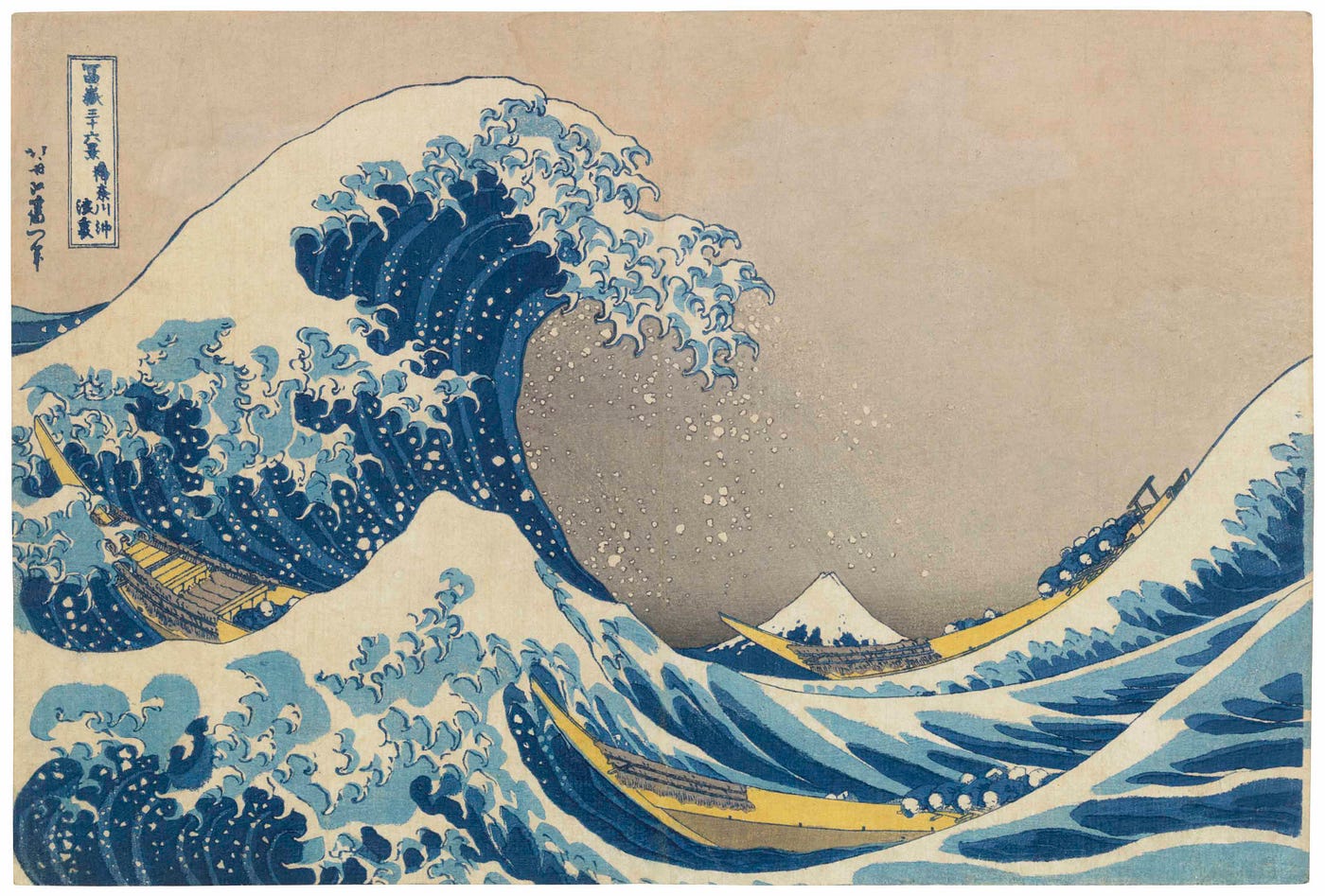
As discussed, we have lost the ‘fight against climate change’ before we started, simply from the way we look at the problem. ‘We’ are not the relevant species and ‘fighting’ is not the right metaphor. All of our ideas of ‘victory’ hinge on further domination of nature which is why we’re ‘losing’ in the first place. Just ask the old gods or the new. Actual winning would require a level of sacrifice we consider disastrous in and of itself. We are a bunch of hairless apes, ruled by corporations, picking a fight with the fucking weather. This is as stupid as it sounds.
Regardless of the theoretical possibility of ‘beating’ climate change (why are we always hitting?), it is (also as discussed) simply too late. The time to stop corporate colonialism was in the 1600s, the time to stop capitalism was in the early 1900s, and the time to address the growing symptoms of collapse was in the 1970s, at best. As you may have noticed we are multiple doubling cycles later, ie, way too late. Exponential growth is a bitch, and it’s a boss bitch now.
The gods may move slow, but when they do move, they move inexorably. We feel like we have control over climate collapse but we don’t. This change has been a long time coming and we just happen to be here when it plays out. It’s like being on the beach and seeing a tsunami coming in. It’s a category error to ‘stop’ it and too late to run. What’s happening is much is bigger than us, and it’s the big one.
Given that we’ve already lost to climate change, the most important question is: what does losing look like? What do the limits to growth look lie once you hit them? There’s no better place to look than the book The Limits To Growth from 1972. Unfortunately, there’s no worse time than now, nearly two doubling cycles later. What was a prediction then is an unsolvable predicament now. We were born in the age of fucking around, but we will die in the age of finding out.
The FA Era
The Limits To Growth (LtG) crew ran a computer model called World3 which calculated how different forces — population, pollution, industrial growth— would interact in the future. Unlike conventional economic models — which completely ignore the environment — these models accounted for things like finite resources and pollution and, spoiler alert, the environment will not be ignored. As Patrick Swayze said, “nobody puts baby in a corner!”
The Limits To Growth results were roundly condemned/ignored by people at the time and they seemed to be right. After the 1970s oil crisis humans and corporations just dug up more fossil fuels and printed more money and made more VCRs. Francis Fukuyama declared ‘the end of history’ and everyone was supposed to ‘develop’ along the same lines. It was actually the end of the world. The actual results are in, and they’re not good.
In 2008, Graham Turner published “A comparison of The Limits to Growth with 30 years of reality.” As he said, ‘the historical data compared favorably with the model output.’ For us people living in the model, however, this is doubleplus ungood. As Turner wrote:
As shown, the observed historical data for 1970–2000 most closely match the simulated results of the LtG ‘‘standard run’’ scenario for almost all the outputs reported; this scenario results in global collapse before the middle of this century [around 2050]. The comparison is well within uncertainty bounds of nearly all the data in terms of both magnitude and the trends over time. Given the complexity of numerous feedbacks between sectors incorporated in the LtG World3 model, it is instructive that the historical data compare so favorably with the model output.
To return to the more complicated model, you can see the Limits To Growth predictions here (focus on the green line) and how they panned out (purple circles).
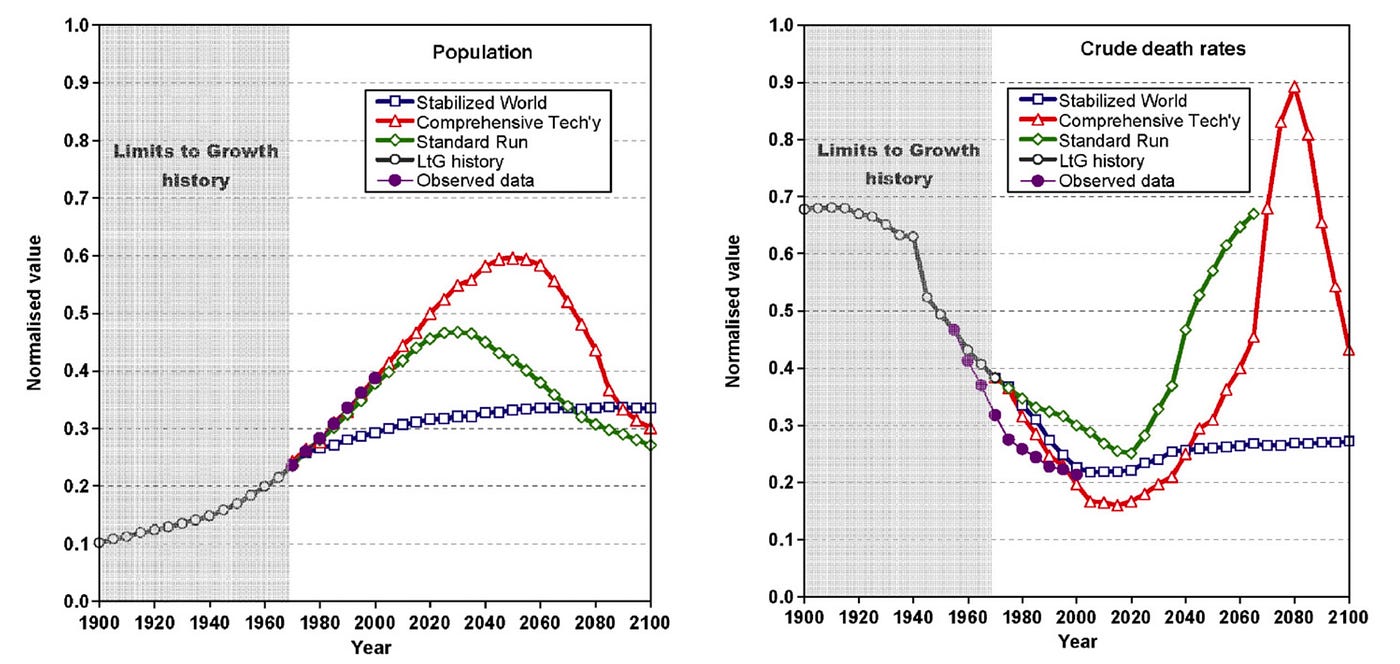
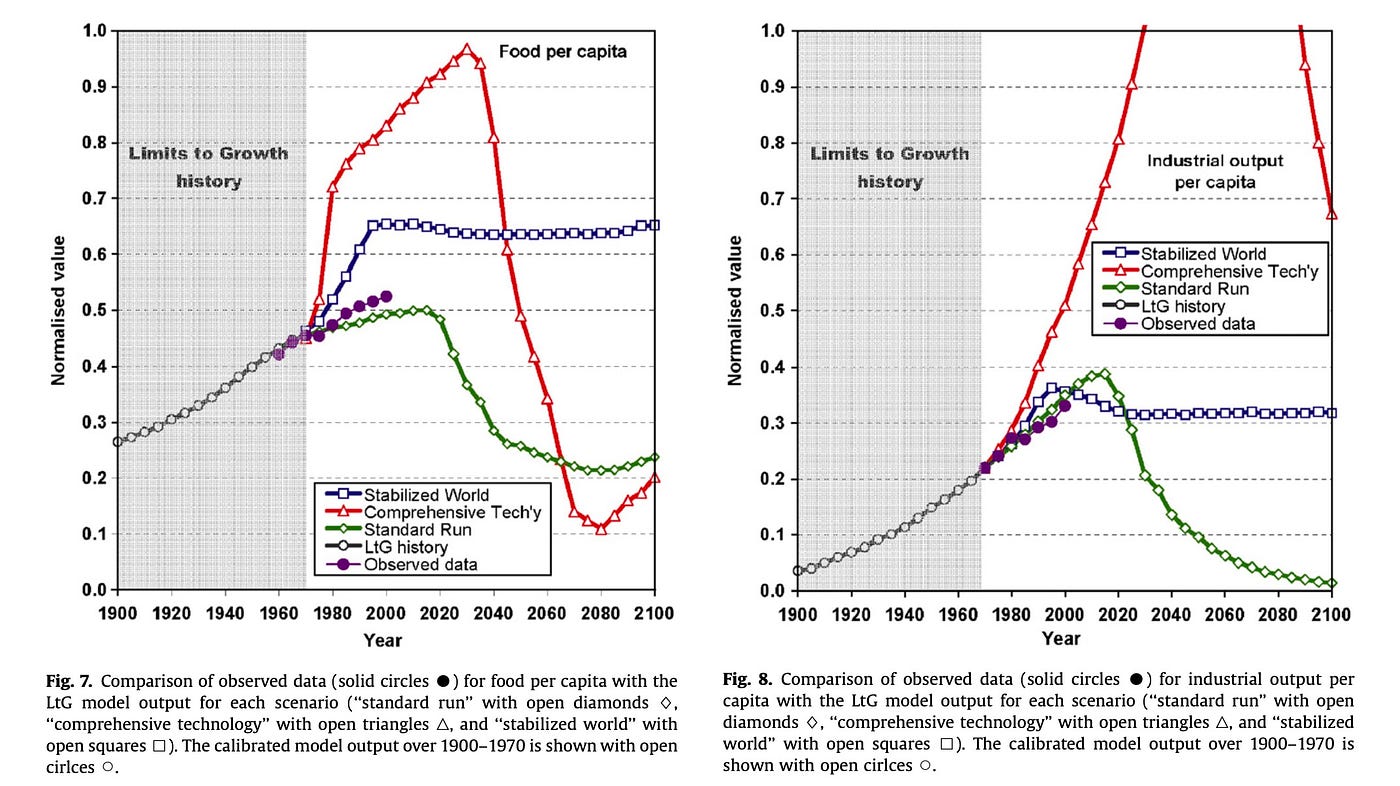
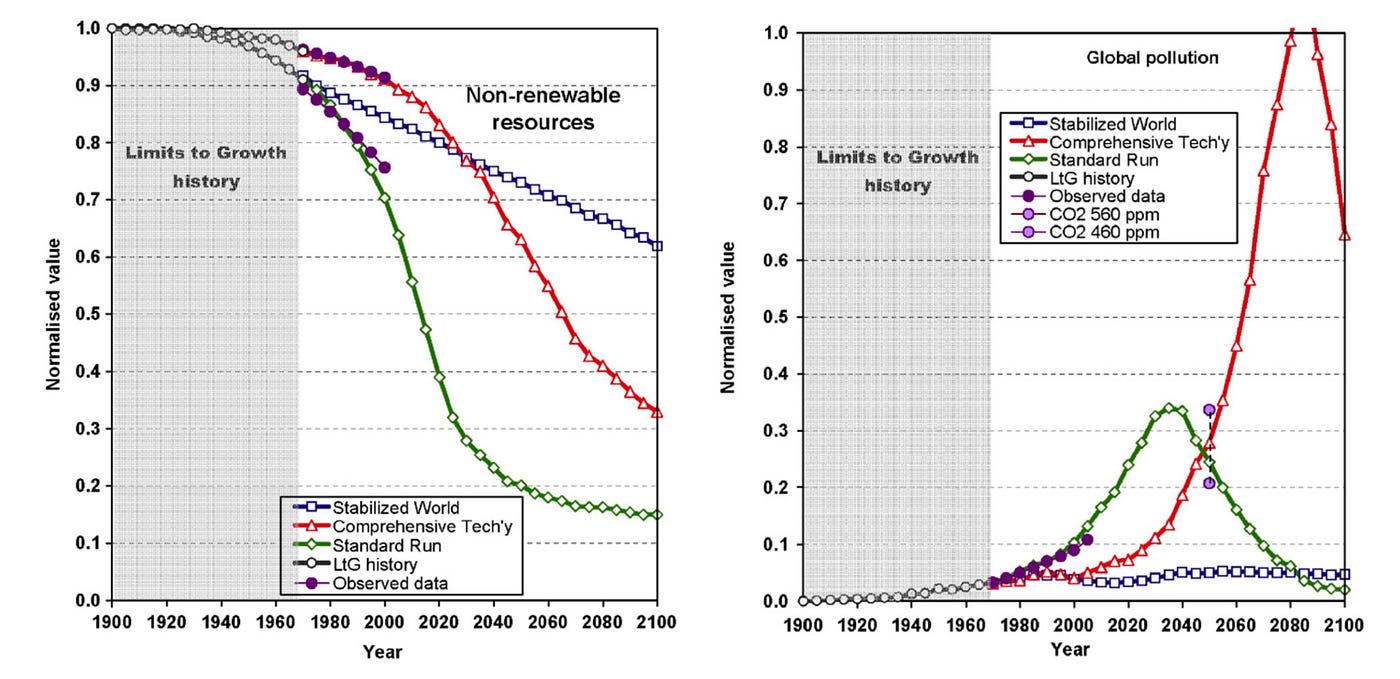
The green line we’re mostly following is called the standard run, because the standard for any exponential growth in a finite space is collapse. The standard run is, broadly speaking, ‘fucking around and finding out’. As Turner describes it:
The ‘‘standard run’’ represents a business-as-usual situation where parameters reflecting physical, economic, and social relationships were maintained in the World3 model at values consistent with the period 1900–1970 [ie, no revolution]. The LtG ‘‘standard run’’ scenario (and nearly all other scenarios) shows continuing growth in the economic system throughout the 20th century and into the early decades of the 21st [ie, still capitalism]. However, the simulations suggest signs of increasing environmental pressure at the start of the 21st century (e.g., resources diminishing, pollution increasing exponentially, growth slowing in food, services, and material wealth per capita) [ie, now]. The simulation of this scenario results in ‘‘overshoot and collapse’’ of the global system about mid-way through the 21st century due to a combination of diminishing resources and increasing ecological damage due to pollution.
One important point in the Limits To Growth is that almost all of the models end here. The default is collapse, and the burden of proof is really on anyone saying we can avoid it. The standard run is surprising accurate, but it’s not really about any particular model. The default scenario for any infinite growth in a finite space is collapse and you don’t need a complicated model for that. It’s napkin level math. If you want to ‘run’ your own basic model, get a chessboard and place one grain of rice on the first square. Then double the amount every square. You’ll see soon enough.
Within the Limits To Growth models, the scenarios we haven’t looked at (red and blue, respectively) are comprehensive technology, which means using technology to solve our problems (doesn’t work) and the stabilized world, which is global climate communism (didn’t happen). These scenarios are effectively moot points now (way too late), but let’s discuss them for academic reasons.
Technological solutions are fundamentally more problem (resource use and pollution) and at best buy you (a little bit) more time. Global climate communism would mean stopping economic growth, controlling population, and distributing resources according to a rigid plan (ie, what westerners call ‘authoritarianism’). This is obviously a non-starter and, anyways, the time to start was 50 years ago. What people chose in the 70s, 80s, and honestly up to today is effectively no action, which is the equivalent of taking strong action. As the Limits To Growth authors said:
Taking no action to solve these problems is equivalent to taking strong action. Every day of continued exponential growth brings the world system closer to the ultimate limits to that growth. A decision to do nothing is a decision to increase the risk of collapse… Because of the delays in the system, if the global society waits until those constraints are unmistakably apparent, it will have waited too long.
This is precisely where we are, over 18,000 days later. We have been growing every single day and we have long since passed the ultimate limits to growth. We are feeling the time-delayed environmental responses to our bullshit, and our only response is bullshit pledges for 2050, ie a full doubling cycle later. We have offered way too little, way too late. The gods are pissed and they’re not fucking around. This is the age of finding out.
The FO Era
When the book was published in 1972, it was honestly too late. Their ‘winning’ scenarios required global climate communism that decade, and we got the opposite of that. Capitalism ‘won’ a Pyrrhic victory and now the world is in flames. Now we are nearly two doubling cycles later and the problem is four times as bad. It is way, way, way, way too late. We are well past the age of fucking around and well into the era of finding out.
Just look at what happens right about now in the standard run. It all just runs away.
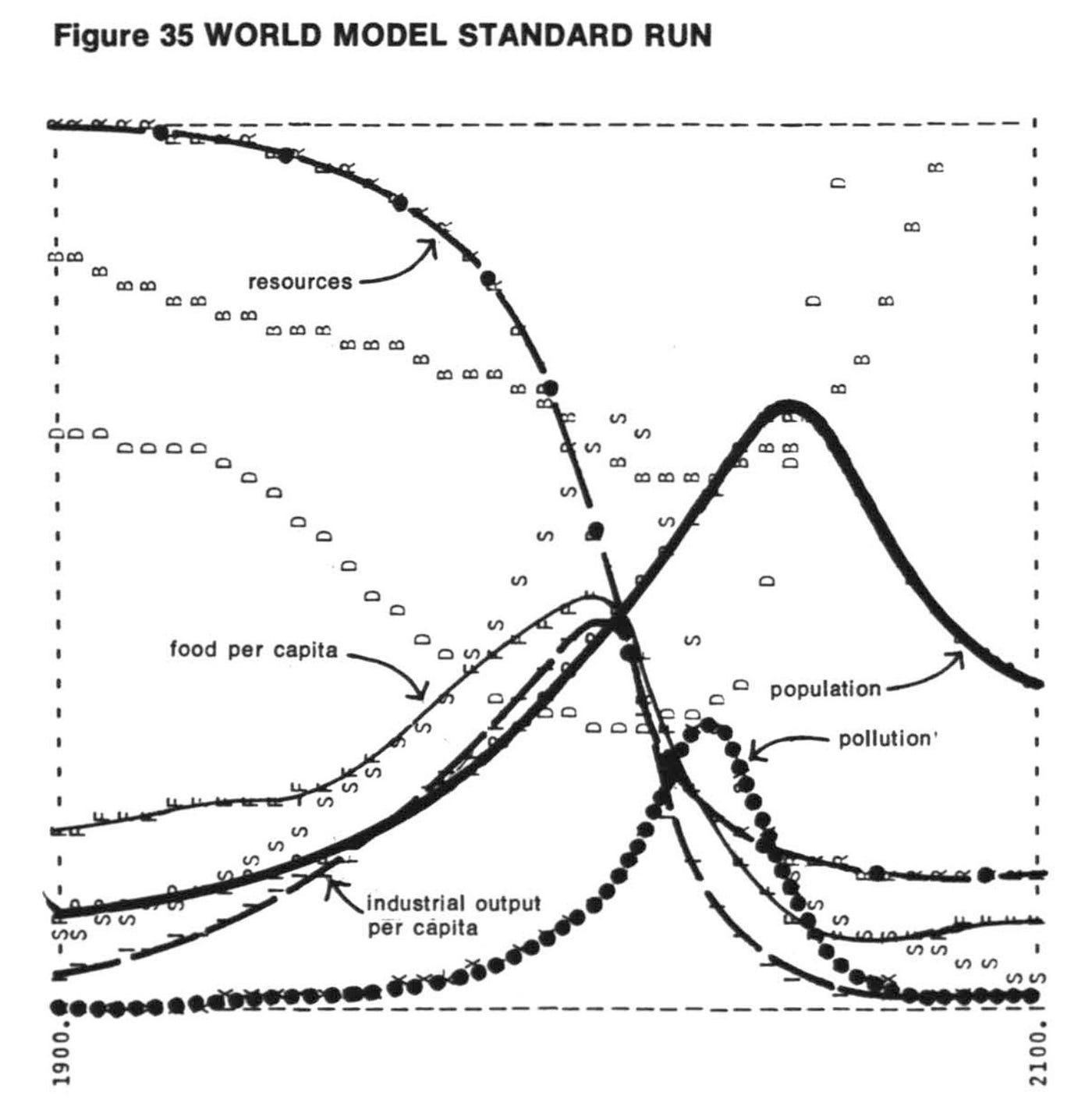
What does this mean for you? Well, as a person, you’re going to see massive population decline in your lifetime. We know this is happening in a gentle way in rich countries, as people have fewer kids, but this won’t be like that. As you can see, the birth rate (marked B) actually goes up. It’s more the death rate (D) spiking and killing people, many of them undoubtably children.
How does that happen? Look at the collapse in food per capita. Right now, every calorie we eat actually contain up to 10 kcal worth of fossil fuel energy. This is an energy return on energy invested (EROIE) of 0.1:1, a wild historic anomaly because we got a one-time inheritance of fossil fuels. As Dr. Tom says in his physics textbook on the subject, “In a sense, we are eating our fossil fuels! It also points to an EROEI of 0.1:1, which is well below break-even. Obviously in times prior to fossil fuels, when we used human and animal labor in our agricultural pursuits, an EROEI less than 1:1 would spell starvation: more energy going in than was recouped from the land.”
We still don’t know how to reliably make fertilizer or do industrial agriculture with ‘renewables’. Even if we did, the energy density of renewables is much lower than fossil fuels (compare 11 kcal/g for gasoline to 0.11 for an alkaline battery, or 0.0001 for a hydroelectric dam). Regardless, if f you grow any consumptive process exponentially, it consumes you. We’re damned if we do and damned if we don’t. Less energy, less resources, and more pollution means one thing. More death. Starvation is just one of the ways to go. As Cutty Ranks said, “six million ways to die, choose one.”
If you look at the graph, you can see natural resources bottoming out as pollution peaks. This is very interesting when you consider our ‘net-zero by 2050’ pledges. These pledges are big business approved because they know that fossil fuel reserves become unprofitable by then. It’s a case of ‘you can’t fire me, I quit’, made to look like something virtuous. In reality, these pledges are an abnegation of any responsibility now and a guarantee of nature dismantling everything quite violently in the future. As the authors said, “a decision to do nothing is a decision to increase the risk of collapse,” and they said this 50 years ago. A pledge to do something in 30 years is, as mentioned, a guarantee.
One thing to remember is that Limits To Growth doesn’t have our myopic focus on CO₂. Today we say that if we just stop (or capture) those emissions we can continue all of our other bullshit. When the LtG authors say pollution, however, they mean pollution in general. ‘Renewables’ also generate and ultimately are pollution. Using ‘renewable’ energy for the same consumer society still digs up the Earth and outputs garbage. There is a fundamental conflict between any type of high industrial output, natural resources, and pollution. It simply crashes, however you run the program. CO₂ is not some magic cheat code. We’re just cheating the future so we can buy dumb shit a bit longer and feel good about it.
One guarantee that will be broken is all the debt this levered up society is floating on. Debt is all borrowed against a more rich future. It’s all borrowed against the idea that there will be more (young) population, more resources, exponentially more in fact. This is all false. Hence you get the mother of all crashes, and the whole planetary Ponzi scheme we call ‘the economy’ comes down. Our present was all stolen from the past (fossil fuels) and borrowed against the future, but debts that can’t be paid won’t be paid. The 500-year Ponzi scheme we’ve called economic growth will all come down, shattering both illusions and reality as it falls.
We are on the standard run and this leads to a dramatic decline in living standards for our descendants. They will literally descend the business end of the graph, and curse us for it. When we completely bottom out, we will reach a kind of involuntary steady state, with vastly diminished resources, industrial capacity, and human population. Resources that could have been used to cushion this collapse will have been forever blown putting precious lithium in dildos, flying footballers around in private jets, and assorted dumb shit that will be remembered only in stories that sound more and more mythical.
This is what the FO era will look like. If you want a sneak preview of how it feels, just look at my country last summer.
What Does Losing Feel Like
I have a miserably unique perspective on this because my country, Sri Lanka, ran out of fossil fuels last year as a western debt-trap clanged shut. What this meant, in real life, is that my car was a paperweight, we had to struggle to get basic foodstuff, and the economy seized up and collapsed. Only the very rich could ‘switch’ to ‘renewables’ because money and shipping and everything required to get these things broke down. After a brief period of solidarity where rich people took the bus and grew food, the country got effectively colonized again, this via the IMF.
Sri Lanka ‘recovered’ from this collapse by sacrificing its poor and entire generations of young people to the dictates of the new colonizers (same as the old colonizers). So now we get more oil and more debt so foreign bondholders and the local comprador class can make a bit more money until the whole thing goes down. But the same structural problems are there locally (we’re a debt colony) and we’re sailing into the same global headwinds as everyone else. Sri Lankans are merely the canaries in the coal mine and giving us another shot of adrenaline does not change the fact that the atmosphere is poisonous and we should all get out.
The thing that makes me the angriest is that even at the point of collapse, the rich reacted by preserving their privileges, while the poor, the very young, and the very old are suffering so bitterly. Most people in my country are not eating well, and many have proper protein maybe once a week. It breaks my heart.
Globally we saw this same craven behavior (driven by corporate profit-seeking, really) play out with COVID-19. I fear this is the same playbook they’ll run during climate collapse because we haven’t learned anything or overthrown anybody (properly). We’re just going to keep pulling our heads above water for a few years at a time, never acknowledging that we’re drowning and we should maybe build an ark instead of electric cars.
I’ve had a preview of what losing would look like and I don’t wish it on anybody. And yet it is coming for everybody. I don’t know what else to say, besides I’m sorry. This is what losing looks like. It’s a loss. You can read the charts or see my people’s hungry eyes. You can physically see the next generation of Sri Lankans being lost, and no island is an island, climatically speaking. That fate is coming to all our descendants, globally. It’s just a timing difference.
Billy Joel sang, “We didn’t start the fire, But we tried to fight it,” but we really didn’t. We just lived what we thought were standard lives, crashing into the inevitable end of the standard run. As it will read on our tombstone, “they were born in the age of fucking around, they died in the age of finding out.” As Shelley said, “Nothing beside remains. Round the decay, Of that colossal Wreck, boundless and bare, The lone and level sands stretch far away.”